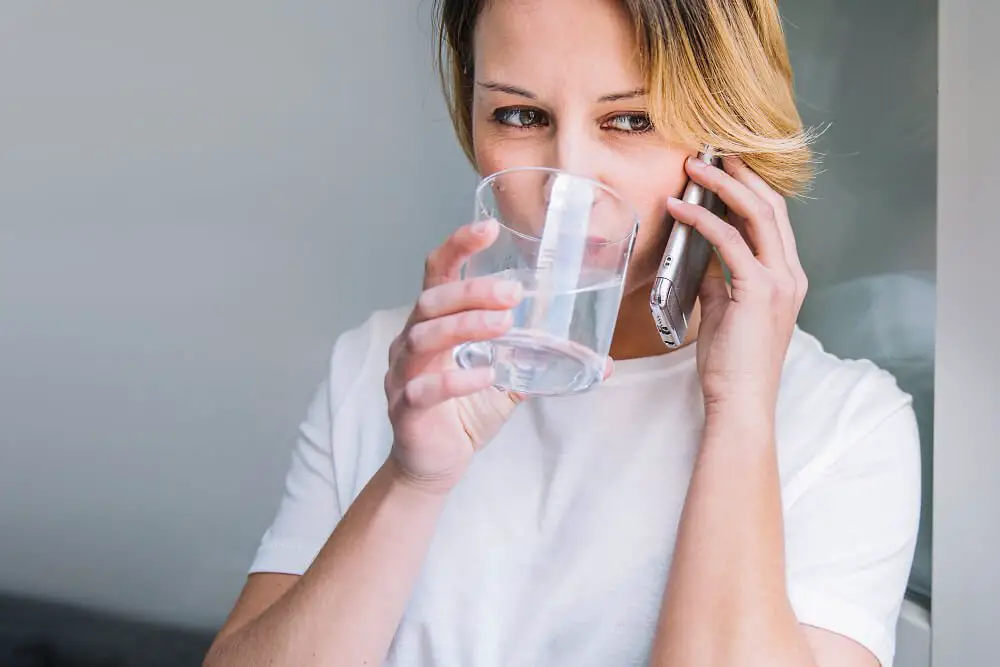Last Updated on August 9, 2023 By Emma W. Thomas
A Brita water filter works by utilizing activated carbon to adsorb contaminants, chlorine, and impurities from tap water, enhancing taste and quality. Water passes through the filter, with carbon trapping unwanted substances, resulting in cleaner and better-tasting water.
How Does A Brita Water Filter Work?

1. The Initial Stage: Activated Charcoal
The first line of defense in a Brita filter is activated charcoal, also known as activated carbon. This is a form of carbon processed to have small pores, increasing its surface area, and making it highly absorbent. The activated carbon in a Brita filter works to remove certain particles, such as chlorine, from the water and helps to reduce unpleasant odors and tastes.
2. Ion-Exchange Resin:
Brita filters also contain an ion-exchange resin in bead form. This resin is composed of polystyrene sulfonate and is specifically designed to attract and bond with ions of heavy metals such as lead and copper. This process effectively removes these harmful contaminants from the water.
3. The Power of Filtration:
To understand the capacity of Brita filters, it’s important to recognize that they can effectively reduce up to 60 various types of contaminants. This includes elements like zinc, copper, cadmium, mercury, and chlorine, thus providing healthier, better-tasting water.
4. Filter Replacement:
For a Brita filter to maintain its effectiveness, it needs to be replaced regularly. Brita recommends replacing standard filters every 40 gallons, which roughly translates to approximately two months for the average household. This helps to ensure that the activated charcoal and ion-exchange resin continue to function effectively.
5. Enabling Healthy Hydration:
By removing harmful contaminants and improving the taste of water, Brita filters encourage healthier hydration habits. More people are inclined to drink water when it tastes good, which is a boost to overall health and well-being.
| Brita Filter Component | Function |
|---|---|
| Activated Charcoal | Removes certain particles such as chlorine, reducing unpleasant odors and tastes. |
| Ion-Exchange Resin | Attracts and bonds with ions of heavy metals, effectively removing these contaminants from the water. |
| Filtration Capacity | Effective in reducing up to 60 types of contaminants for healthier, better-tasting water. |
| Filter Replacement | Recommended every 40 gallons for consistent and effective function. |
| Health Benefits | Encourages healthier hydration habits by improving the taste of water and removing contaminants. |
In a nutshell, a Brita filter works by utilizing activated charcoal and ion exchange processes to reduce unwanted particles and substances, providing clean, crisp, and delicious water.
Define Carbon Filtration In Detail For Water Filters
Carbon filtering is a process of filtering water that uses a sheet of activated carbon, which attracts all the contaminants with the process of chemical absorption. Pollutants in the water are trapped inside the pore structure of carbon molecules. It attracts the contaminant molecules, and they stick to the activated carbon.
The sheet has a high surface area of porous carbon granules, which is effective in absorbing all impurities in water. This technique is efficient in removing.
- Chlorine
- Hydrogen sulfide
- Lead, copper, and mercury
- Pesticides
- Organic compound that affects the smell and taste of water
This makes the water clean and removes impurities and substances with a bad odor.
Activated carbon filters are incapable of removing nitrates, minerals, and other microorganisms. However, the dissolved minerals are not harmful, and the tap water is already treated to remove bacteria and viruses. Hence carbon filtering is an effective method of water filtration used in Brita filters. This method is used in conjunction with ion exchange resins.
Define The Process Of Ion Exchange Resins For Water Purification.
Ion exchange resin for water purification involves passing water through a spherical porous bed of ions. Ions in the water are exchanged for ions on the porous bed. The two most common methods are softening and deionization.
Softening is generally performed before the process of reverse osmosis to treat water to reduce its hardness. The sodium and magnesium ions are exchanged for calcium ions from the ion bed. The exchange ratio is generally two to one. This is a pre-treatment process that reduces the hardness of water and makes it ready for the RO process.
Deionization beads exchange hydrogen ions for cations and hydroxyl ions for anions. Deionization is effective when used with other methods such as reverse osmosis or carbon absorption. Brita Filters uses it in conjunction with carbon filtration.
Despite performing both methods, some sediment may remain suspended in the water. They are neither attracted by carbon molecules nor exchanged for other ions. These sediments need to be removed, and for that, an additional layer of the filter may be used, which settles the sediments and removes them.
Is The Working Of Brita Filters Affected By Its Lifetime?
The lifetime of Brita filters is an important aspect that needs to be paid attention to. If you do not replace your Brita filter on time, the water will remain impure. This is as good as drinking tap water. Also, all the impurities that remain in the water filter can lead to the growth of harmful substances that can affect the purity of your tap water adversely. Hence choosing the right filter and replacing it on time are very important.

The Following Table Summarizes The Life Of Brita Filters Along, I.E., The Time When They Need To Be Replaced.
| Type Of Filter | The Life Span Of The Filter | Filter Capacity. |
| Brita Standard Filters | 2 months | 40 gallons |
| Longlast Filters | 6 months | 120 gallons |
| Stream Filters | 2 months | 40 gallons |
| Bottle Filters | 2 months | 40 gallons |
| Faucet Filters | 4 months | 100 gallons |
The table gives an estimate of filter capacity. The capacity of a filter will also depend on the hardness of water and the impurities dissolved in it.
Explain The Working Of Different Brita Filters.
Brita filters primarily use the process of carbon absorption and reverse ion exchange. However, it can also use some other methods in conjunction with the above-mentioned process to remove sediments from water.
The process of filtration in the Brita filter is dependent on the filter used.
The types of filters used are mentioned below.
1. Brita Standard Filter
Brita’s standard filter uses a screen mesh to remove black flecks and other impurities from water. It uses the process of carbon absorption to remove mercury and chlorine from water. This improves the taste and odor of water. The next process is the process of ion exchange resins, which capture copper, zinc, and cadmium ions. These three processes ensure that water is odorless and fit for drinking and does not contain any impurities. These filters can purify up to 40 gallons of water without replacement.
2. Longlast Filters
These filters contain a patent-protected pleated media and proprietary active filtering agent to remove impurities such as lead, asbestos, cadmium, etc. These filters can be used in all Brita pitchers and Brita dispensers except for Stream & Infinity pitchers. Longlast filters, as the name suggests, have a long replacement period and can purify up to 120 gallons of water.
3. Stream Filters
These filters use the carbon absorption method to reduce impurities from water. It features a dual-layer carbon form. This proprietary technology helps reduce the chlorine taste and odor and makes the water fit for drinking. Stream filters can purify around 40 gallons of water.
4. Bottle Filters
The bottle filters, as the name suggests, are designed to fit in Brita bottles and will give you clean drinking water on the go. These filters use the carbon block form to reduce chlorine taste and odor and purify the water as you drink it. They can effectively purify up to 40 gallons of water without being replaced.
5. Faucet Filters
Faucet filters purify the water flowing from your faucet. It uses a nonwoven material and a carbon block to remove impurities from the water. The water from the faucet is forced to pass through a non-woven material layer that settles all the sediments. The water then passes through the carbon layers, which capture smaller contaminants. It reduces lead, asbestos, chlorine, benzene, etc. The filter can provide you with up to 100 gallons of purified water in its lifetime.
References:
https://www.brita.com/better-water/how-do-brita-filters-work/
https://www.medicalnewstoday.com/articles/do-brita-filters-work-effectiveness-and-what-they-filter
Emma is a graduate of Domestic Science or Family and Consumer Sciences (Home Economics) from the University of Wisconsin. She has 7 years of experience Working with the strategic section of BestBuy and now writing full-time for Homeeon.
From Managing the Home, Interiors, Cleaning, and Exteriors to Gardening and everything about Making A Home Liveable – is her passion and this Homeeon is the result of this.
Emma loves decorating her home with the best stuff found online. She cares about quality over anything and writes reviews about them here in Homeeon. Get in touch with her over Pinterest.
Keep reading her blogs.

